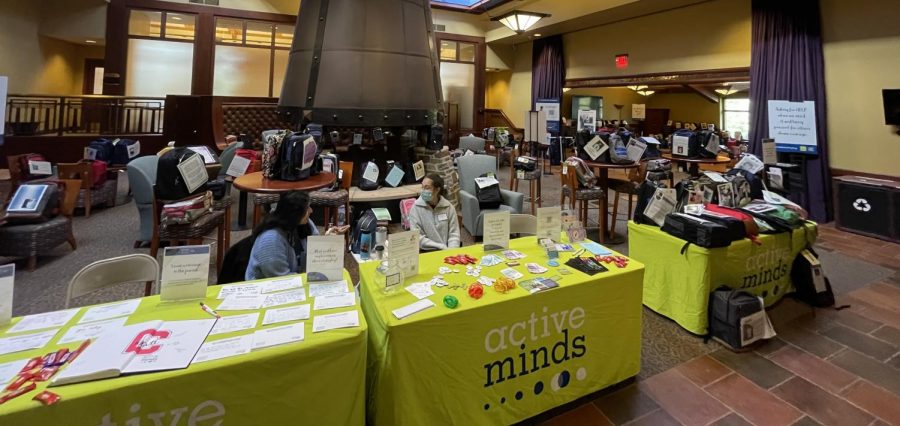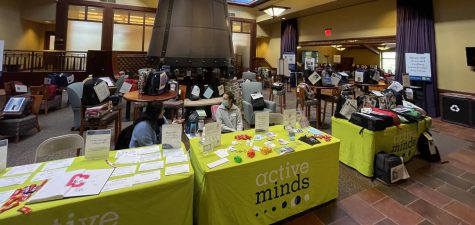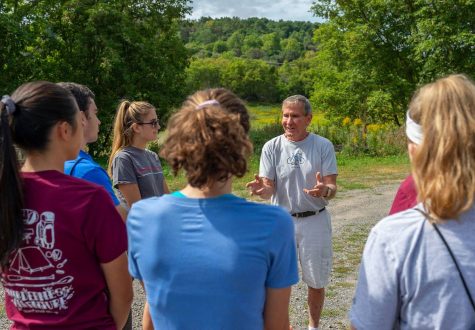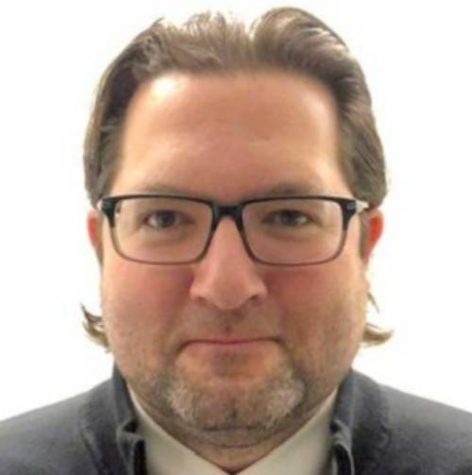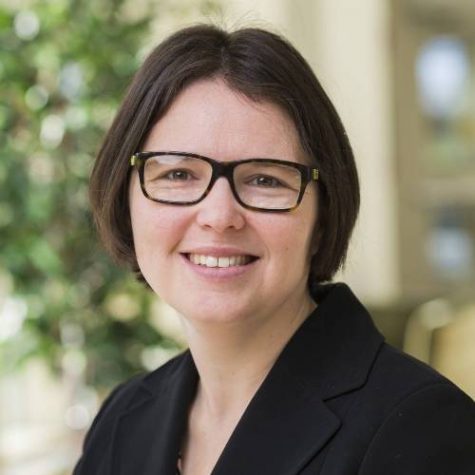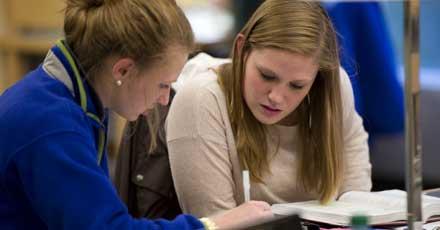Printed with permission of Emma Hoesterey
SEND SILENCE PACKING: Hoesterey organized an exhibit to promote mental health resources.
Striving for Holistic Wellbeing: Shaw Wellness Institute
TW: Mentions of sexual violence and suicide.
For some on Colgate’s campus, the Shaw Wellness Institute (Shaw) isn’t much more than the physical structure at the front of the 113 Broad Complex. What they may not know is that Shaw offers a multitude of programs, services, events, workshops and more that primarily serve to make the lives of students, faculty and staff at Colgate better overall. Educating, connecting and inspiring members of the Colgate community is Shaw’s mission, extending from sexual assault prevention and education to treatment and recovery in multiple areas of wellness.
Shaw’s programming is guided by the “Eight Dimensions of Wellness,” encapsulating the holistic nature of living a well-balanced life. The eight dimensions are: emotional, environmental, financial, intellectual, occupational, physical, social and spiritual. At Shaw, they strive to include resources that pertain to each of these areas.
Boyd (BK) Taylor, the director of Shaw, has a deep passion and understanding of holistic wellness, and the desire to make wellness accessible to everyone.
“An excellent way for students to get connected to [Shaw] is to ask themselves, ‘Where are they on their wellness journey?’ and ‘Where would they like to be?’ From there, Shaw can help connect interested students with Shaw’s services and a myriad of other options available through Shaw’s partnerships with other departments on campus and in the community. Shaw is for everyone, and we are here to help each student with their wellness journey,” Taylor said.
Shaw serves as a central resource for almost everything involving health and wellness on campus, working with campus partners such as Student Health Services and Haven. Various programs include dietician services, an eating issues management team, bystander workshops, alcohol and drug services and an ambassador program. During the COVID-19 pandemic, Shaw provided many virtual resources for all community members looking for help during those tough months.
Colgate students take on various roles at Shaw as ambassadors for the community. In these positions, students are able to help better the community while becoming involved in the resource center.
Sophomore Folade Olusanya, the ALANA Cultural Center liaison for Shaw, just became involved with Shaw this year but already understands the impact that Shaw can and does have on the Colgate community.
Olusanya described ALANA’s mission as wanting everyone to feel like they have a sense of belonging at Colgate, which clearly ties into wellness and the work being done at Shaw.
“I think we can really be active in making sure that everyone on campus is being cared for and that Colgate is looking out for them since sometimes it can feel really isolating. … I wanted to be involved with Shaw because I wanted to make sure that that doesn’t happen to other students and that people feel that their health comes first, before anything else,” Olusanya explained.
Sophomore Nicholas Cinnamo, the alcohol and drugs liaison, holds similar thoughts about how Shaw can help students on campus.
“I started working at Shaw this semester, and I primarily got involved because I care about the physical and mental well-being of my friends, classmates and peers at Colgate. After my first year at Colgate, I’ve just realized how prevalent mental health issues are, and I wanted to join an organization that prioritizes student wellness and happiness,” Cinnamo said.
In his role at Shaw, Cinnamo creates posters and presentations about alcohol and drugs that promote safe and reasonable behavior.
“College brings a variety of academic and social stress, as well as other personal difficulties that students may be experiencing. So, it is very important to have a place that allows students to safely and comfortably talk about what they are going through, and that is what Shaw hopes to provide,” Cinnamo explained.
Junior Eva Wiener, a peer coach at Shaw, similarly recognizes Shaw’s impact on the community. The peer coach program is new this year and offers an alternative for students who wish to talk to someone in a therapy-like session, but who may not feel comfortable meeting with a therapist. Wiener explained the high demand at the counseling center and how the peer coach program can offer an alternative to students hoping for an additional resource.
“I think we’re doing a couple of things in lessening the load that’s on the counseling center, but I also just think there are a lot of people who don’t want to talk to a professional and I think maybe they’ve grown up in an environment where [talking to a therapist] has just been stigmatized by their family or their community. … So it’s just helpful to have this extra resource for people who could be afraid to go to traditional counseling. … I just think it’s really special to give someone that comfort of talking to someone their own age.”
Since the program is brand new, it’s been difficult for the peer coaches to spread the word about this crucial resource. The majority of Shaw’s programs are led by students, so Wiener hopes that people will begin to hear about the peer coach program more and be willing to give it a try.
“With peer coaching, it’s just kind of allowing students to take control of the mental health narrative around campus, which I think is really important. We’re the ones who are in this environment … so we’re able to make differences that the student body really cares about and wants because we know what students want,” Wiener said.
Another program that Shaw leads is the bystander intervention program, which involves student-led presentations about the importance of being an active bystander. All first-years take the bystander intervention program. The “Sexual Violence 1.0” facilitation touches on rape culture, consent, alcohol and being an active bystander in situations involving sexual violence. The 2.0 facilitation is presented to members of various student organizations and delves deeper into the topics. Junior James Clark, one of the facilitators, shared a bit about what he thinks this program adds to the community.
“Unfortunately, sexual violence and rape culture are normalized parts of Colgate’s campus. As bystander intervention facilitators, our team at Shaw aims to educate our community, not just about sexual violence and rape culture, but also about how we as a community can work together to intervene in and dismantle it. In doing so, we provide our community with the tools to understand when and how to best intervene in problematic situations that perpetuate rape culture and sexual violence,” Clark explained.
Junior Emma Hoesterey echoed the importance of Colgate students having Shaw as a resource on campus. Hoesterey is currently a peer coach. She was previously the social media director and was involved with the programming team to plan events that focused on outreach to the community.
“I think that there just needs to be more of an understanding … especially to the first-year students, that we have a lot of resources here [at Shaw]. I have just heard from so many people and even experienced myself that this campus can feel really isolating, especially [during the first year] where eating, sleeping and socializing all happen essentially [at] the top of the hill,” Hoesterey said. “I just think that there should be a really large focus on [Shaw] and the counseling center, and [students should know] that we are a resource … [and] you’re not alone in this. College is tricky. Transitions are hard, especially in this location.”
Hoesterey led the charge on creating a “Send Silence Packing” exhibit at Colgate, which is a part of the Active Minds organization, a large non-profit working to change the culture around mental health. The exhibit strives to inspire action for suicide prevention and education. On Thursday, Oct. 28, community members visiting the O’Connor Campus Center [the Coop] were able to see a backpack display exploring mental health themes, including personal stories from people who have lost someone close to them from suicide.
Hoesterey came across the exhibit after exploring the Active Minds organization and realizing that the display could be really effective on Colgate’s campus. The exhibit was almost entirely student-run, with almost all the mental health resources on campus participating in the exhibit by tabling at the Coop.
“It was beyond rewarding when it was done. … The students on this campus really are ready for these dialogues around mental health. I think the climate of this campus is very proactive and very accepting of trying to destigmatize mental illness. The mental health resources are [here] — they’re just not really known about for some reason, or not well-perceived. I’m not really sure where the disconnect lies. But it was fascinating to just see it all come together [with the exhibit].”
Hoesterey had many people reach out to her after the exhibit, hoping to get more involved in suicide awareness at Colgate.
“What I didn’t even realize was that this exhibit can be almost something like a starting point, like a jumping-off point for these conversations. I want this to be continued and use the success of the exhibit and people’s attitudes towards it to really show that we’re ready for this and that this is something that our students are passionate about. I really can’t say enough great things about all the volunteers [who] helped with the exhibit. Students are really interested and, out of the goodness of their hearts, want to make a difference in destigmatizing mental health. I honestly have a lot of faith that more will come from this,” Hoesterey said.
Hoesterey explained how everyone at Shaw is already really supportive and ready to have these serious dialogues, but was pleasantly surprised by the number of students on campus who feel the same way.
“I credit my desire to do these initiatives a lot from the amazing community [at Shaw]. The people I’m surrounded with have shown me that this is something that people are really passionate about,” Hoesterey said. “I was definitely really nervous at first to run this exhibit, but [everyone being so supportive] made it less overwhelming. It just became a possibility that it could really happen.”
Check out the programs available at Shaw if you or anyone you know is struggling with their mental health, or if you want to just get involved in a passionate and expanding community on campus.
Striving for Holistic Wellbeing: Shaw Wellness Institute
Printed with permission of Emma Hoesterey
SEND SILENCE PACKING: Hoesterey organized an exhibit to promote mental health resources.
TW: Mentions of sexual violence and suicide.
For some on Colgate’s campus, the Shaw Wellness Institute (Shaw) isn’t much more than the physical structure at the front of the 113 Broad Complex. What they may not know is that Shaw offers a multitude of programs, services, events, workshops and more that primarily serve to make the lives of students, faculty and staff at Colgate better overall. Educating, connecting and inspiring members of the Colgate community is Shaw’s mission, extending from sexual assault prevention and education to treatment and recovery in multiple areas of wellness.
Shaw’s programming is guided by the “Eight Dimensions of Wellness,” encapsulating the holistic nature of living a well-balanced life. The eight dimensions are: emotional, environmental, financial, intellectual, occupational, physical, social and spiritual. At Shaw, they strive to include resources that pertain to each of these areas.
Boyd (BK) Taylor, the director of Shaw, has a deep passion and understanding of holistic wellness, and the desire to make wellness accessible to everyone.
“An excellent way for students to get connected to [Shaw] is to ask themselves, ‘Where are they on their wellness journey?’ and ‘Where would they like to be?’ From there, Shaw can help connect interested students with Shaw’s services and a myriad of other options available through Shaw’s partnerships with other departments on campus and in the community. Shaw is for everyone, and we are here to help each student with their wellness journey,” Taylor said.
Shaw serves as a central resource for almost everything involving health and wellness on campus, working with campus partners such as Student Health Services and Haven. Various programs include dietician services, an eating issues management team, bystander workshops, alcohol and drug services and an ambassador program. During the COVID-19 pandemic, Shaw provided many virtual resources for all community members looking for help during those tough months.
Colgate students take on various roles at Shaw as ambassadors for the community. In these positions, students are able to help better the community while becoming involved in the resource center.
Sophomore Folade Olusanya, the ALANA Cultural Center liaison for Shaw, just became involved with Shaw this year but already understands the impact that Shaw can and does have on the Colgate community.
Olusanya described ALANA’s mission as wanting everyone to feel like they have a sense of belonging at Colgate, which clearly ties into wellness and the work being done at Shaw.
“I think we can really be active in making sure that everyone on campus is being cared for and that Colgate is looking out for them since sometimes it can feel really isolating. … I wanted to be involved with Shaw because I wanted to make sure that that doesn’t happen to other students and that people feel that their health comes first, before anything else,” Olusanya explained.
Sophomore Nicholas Cinnamo, the alcohol and drugs liaison, holds similar thoughts about how Shaw can help students on campus.
“I started working at Shaw this semester, and I primarily got involved because I care about the physical and mental well-being of my friends, classmates and peers at Colgate. After my first year at Colgate, I’ve just realized how prevalent mental health issues are, and I wanted to join an organization that prioritizes student wellness and happiness,” Cinnamo said.
In his role at Shaw, Cinnamo creates posters and presentations about alcohol and drugs that promote safe and reasonable behavior.
“College brings a variety of academic and social stress, as well as other personal difficulties that students may be experiencing. So, it is very important to have a place that allows students to safely and comfortably talk about what they are going through, and that is what Shaw hopes to provide,” Cinnamo explained.
Junior Eva Wiener, a peer coach at Shaw, similarly recognizes Shaw’s impact on the community. The peer coach program is new this year and offers an alternative for students who wish to talk to someone in a therapy-like session, but who may not feel comfortable meeting with a therapist. Wiener explained the high demand at the counseling center and how the peer coach program can offer an alternative to students hoping for an additional resource.
“I think we’re doing a couple of things in lessening the load that’s on the counseling center, but I also just think there are a lot of people who don’t want to talk to a professional and I think maybe they’ve grown up in an environment where [talking to a therapist] has just been stigmatized by their family or their community. … So it’s just helpful to have this extra resource for people who could be afraid to go to traditional counseling. … I just think it’s really special to give someone that comfort of talking to someone their own age.”
Since the program is brand new, it’s been difficult for the peer coaches to spread the word about this crucial resource. The majority of Shaw’s programs are led by students, so Wiener hopes that people will begin to hear about the peer coach program more and be willing to give it a try.
“With peer coaching, it’s just kind of allowing students to take control of the mental health narrative around campus, which I think is really important. We’re the ones who are in this environment … so we’re able to make differences that the student body really cares about and wants because we know what students want,” Wiener said.
Another program that Shaw leads is the bystander intervention program, which involves student-led presentations about the importance of being an active bystander. All first-years take the bystander intervention program. The “Sexual Violence 1.0” facilitation touches on rape culture, consent, alcohol and being an active bystander in situations involving sexual violence. The 2.0 facilitation is presented to members of various student organizations and delves deeper into the topics. Junior James Clark, one of the facilitators, shared a bit about what he thinks this program adds to the community.
“Unfortunately, sexual violence and rape culture are normalized parts of Colgate’s campus. As bystander intervention facilitators, our team at Shaw aims to educate our community, not just about sexual violence and rape culture, but also about how we as a community can work together to intervene in and dismantle it. In doing so, we provide our community with the tools to understand when and how to best intervene in problematic situations that perpetuate rape culture and sexual violence,” Clark explained.
Junior Emma Hoesterey echoed the importance of Colgate students having Shaw as a resource on campus. Hoesterey is currently a peer coach. She was previously the social media director and was involved with the programming team to plan events that focused on outreach to the community.
“I think that there just needs to be more of an understanding … especially to the first-year students, that we have a lot of resources here [at Shaw]. I have just heard from so many people and even experienced myself that this campus can feel really isolating, especially [during the first year] where eating, sleeping and socializing all happen essentially [at] the top of the hill,” Hoesterey said. “I just think that there should be a really large focus on [Shaw] and the counseling center, and [students should know] that we are a resource … [and] you’re not alone in this. College is tricky. Transitions are hard, especially in this location.”
Hoesterey led the charge on creating a “Send Silence Packing” exhibit at Colgate, which is a part of the Active Minds organization, a large non-profit working to change the culture around mental health. The exhibit strives to inspire action for suicide prevention and education. On Thursday, Oct. 28, community members visiting the O’Connor Campus Center [the Coop] were able to see a backpack display exploring mental health themes, including personal stories from people who have lost someone close to them from suicide.
Hoesterey came across the exhibit after exploring the Active Minds organization and realizing that the display could be really effective on Colgate’s campus. The exhibit was almost entirely student-run, with almost all the mental health resources on campus participating in the exhibit by tabling at the Coop.
“It was beyond rewarding when it was done. … The students on this campus really are ready for these dialogues around mental health. I think the climate of this campus is very proactive and very accepting of trying to destigmatize mental illness. The mental health resources are [here] — they’re just not really known about for some reason, or not well-perceived. I’m not really sure where the disconnect lies. But it was fascinating to just see it all come together [with the exhibit].”
Hoesterey had many people reach out to her after the exhibit, hoping to get more involved in suicide awareness at Colgate.
“What I didn’t even realize was that this exhibit can be almost something like a starting point, like a jumping-off point for these conversations. I want this to be continued and use the success of the exhibit and people’s attitudes towards it to really show that we’re ready for this and that this is something that our students are passionate about. I really can’t say enough great things about all the volunteers [who] helped with the exhibit. Students are really interested and, out of the goodness of their hearts, want to make a difference in destigmatizing mental health. I honestly have a lot of faith that more will come from this,” Hoesterey said.
Hoesterey explained how everyone at Shaw is already really supportive and ready to have these serious dialogues, but was pleasantly surprised by the number of students on campus who feel the same way.
“I credit my desire to do these initiatives a lot from the amazing community [at Shaw]. The people I’m surrounded with have shown me that this is something that people are really passionate about,” Hoesterey said. “I was definitely really nervous at first to run this exhibit, but [everyone being so supportive] made it less overwhelming. It just became a possibility that it could really happen.”
Check out the programs available at Shaw if you or anyone you know is struggling with their mental health, or if you want to just get involved in a passionate and expanding community on campus.
